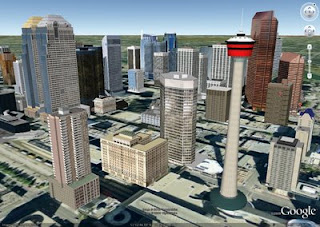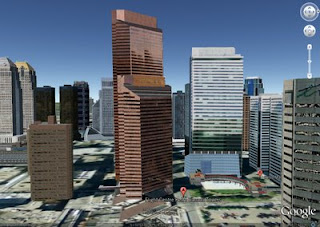Our first Featured Modeler is Andrew, better known as "IntoTheWest," who has almost single-handedly put Calgary, AB Canada on the map. Visit his entire collection to see over 40 models in the Google 3D Warehouse.

Andrew has a thing for Calgary's skyscrapers. He's been modeling the tall buildings textured with his own photographs using Google SketchUp then adding the models to Google Earth for more than three years. "It was a thrill recently when a local TV station showed Google Earth. They flew into downtown Calgary and I thought, wow, those are my buildings," Andrew said during a conversation last week with Google. "From the time I started, I've enjoyed making models. It's kind of like putting together a puzzle when you don't have all the pieces."
Andrew began modeling after a colleague introduced him to Google Earth. He noticed that in some areas, in addition to the satellite imagery, models of buildings were visible. "I'm not an architect, but I have always been a skyscraper buff, and I like photography. I realized that the gray buildings really just scratched the surface of what was possible."
Pretty quickly, Andrew, who is an IT professional and very comfortable working with new software, was able to use SketchUp to pull in a Google Earth placemark, draw a rectangle over one of the buildings and Push/Pull up to the 700-ft height. "It was just a box, but it made me realize that a lot more was possible," he said.

According to Andrew, modeling plays on several of his passions: drawing, architecture, geography and photography. Using his own photographs of Calgary's downtown, Andrew was able to make realistic looking models of some of the major structures in the city center. "Even though my first couple of buildings were rough, from a distance, they looked pretty good," he said.
At the time, Andrew and his wife were expecting their first child and he had some free time during the evenings. He learned more about modeling by watching some of the training videos on the SketchUp site. "It really wasn't that hard. Even though I didn't have a background with CAD or 3D software, I was able to get up to speed quickly." Turning his photographs into effective textures was a bit more challenging. "Learning to texture was the most challenging part. I now use Photoshop Elements to stretch my photos on a 'flat canvas' and then take them into SketchUp." You can see some of Andrew's texturing work on an early building called Petro Canada.

Still he says, "...it never felt like work to me. Once I got into it, it was sort of hard to stop," Andrew admits. He has completed most of the major Skyscrapers in Calgary. He said, "I scaled back on my original plans to do the entire city, but I still get a lot of satisfaction from knowing that my models are now available and used by the world. It made me feel like I wasn't just wasting time."
For the future he thinks many people that have an interest in geography, architecture or just new technology will likely make models for Google Earth. "It's just a fantastic product, not just for the buildings, but as a way of sharing information." While Andrew's time in modeling has decreased, he is still passionate about it, "the great thing is that it makes me feel like I am adding to a world-wide community." Even his son, who is now 2 years-old, recognizes Google Earth, "Daddy, that's the Earth ball."




